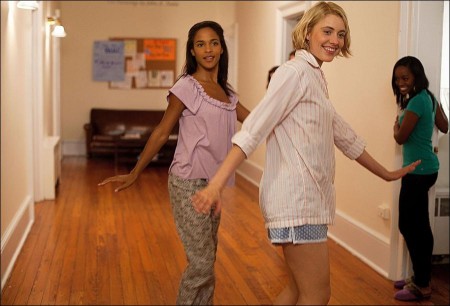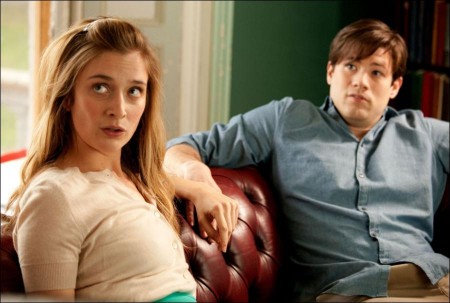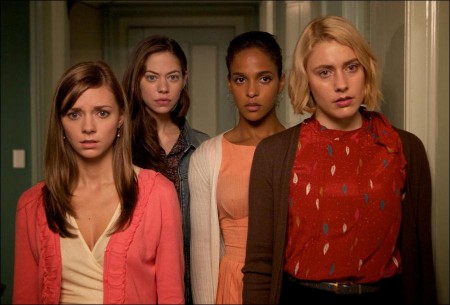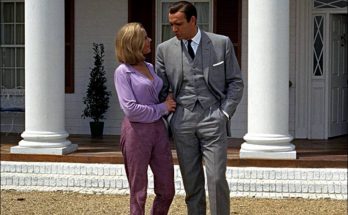Director Whit Stillman talks Damsels in Distress. Returning to college to visit friends some time after graduating everyone was full of stories of an amazing group of girls who had revolutionized campus social life. They dressed up, wore perfume and transformed university socializing which in our day had been grungy and grim.
I never knew the girls or learned any specifics of their escapades but, proposing a college comedy to film companies, I found that analogous groups had emerged at many other colleges in the wake of coeducation. Suddenly I had a film idea more than one company wanted.
Coeducation had swept American university campuses in the very late 1960s and more particularly the early 1970s. But years and decades later some colleges with distinctly male identities still lacked an atmosphere entirely comfortable for women. Our idea was that “Seven Oaks University” would be such a school – a formerly male bastion where decades after coeducation an atmosphere of male barbarism still prevails.
I was fortunate that the project ended up with Liz Glotzer and Martin Shafer at Castle Rock Entertainment with whom I had had such good experiences making BARCELONA and THE LAST DAYS OF DISCO.
Again the experience of writing a script for them was exhilarating, as such supervision rarely is. In late January 2010, a month after submitting the delivery draft, standing on the deserted and windswept main street of Mark Twain’s old haunt — Virginia City, Nevada – I got the call that they wanted to go ahead with a “polish” with the idea of moving ahead with the film soon after.
For the production the pivotal moment came in the spring when we were discussing how to raise financing – the usual frustrating obstacle course of star casting, foreign presales, equity financing, and searching for a domestic distribution deal loomed. Having seen two good projects become hopelessly stuck in that morass I had been thinking of how it could be avoided.
The experience with our first film, METROPOLITAN, had been to go ahead with whatever resources were at hand and that had gone well. The response was that for a film on that scale, or even quite a bit above it, private investment would be immediately available. We were a go but our production had to be compact.
We had already started casting in Los Angeles with the young casting team of Amy Britt and Anya Colloff. Through them we had almost immediately found Analeigh Tipton (part undecided), Aubrey Plaza (part undecided) and Megalyn Echikunwoke for ROSE.
I was starting from the usual position of ignorance with the excuse this time that I’d been living abroad. The film style known as “Mumblecore” I had heard of but not actually witnessed or strained to hear. A meeting with the highly recommended Greta Gerwig was set for a West Village watering hole. As a striking pretty blond we assumed that it would be to play the “bombshell” LILY part.
Fortunately Greta had the insight to see herself in the VIOLET part, and she and her agents did not adhere to the stultifying rule that established actors not audition. After the casting base had shifted to Paul Schnee and Kerry Barden’s operation in New York (Kerry had helped cast THE LAST DAYS OF DISCO) Greta came in to perform the Violet role in all its aspects, including stellar singing and tap dancing turns.
At one casting session Amy and Anya brought an actress in to read for HEATHER who seemed a bit unlikely for that role. It had been a discouraging morning with the script sounding like wood in the mouths of the talented performers who came in and I was in despair.
Suddenly the wooden words made great sense in this actress’s version. She still seemed a stretch for Heather but – in what I learned was a “Mumblecore” pattern – the good actress turned out to be good at other film tasks too: in this case, a terrific director. Lena Dunham had just won the top prize with her film TINY FURNITURE at the South by Southwest and was involved in all sorts of promising activities.
This was a key meeting. Lena became a friend to the production, helped at a table reading, agreed to play a funny part in the film until work on her TV show intervened and — most importantly – introduced us to her film’s co-producer, Alicia Van Couvering. The line producer Cecilia Roque had advised us on all our films and would help on Damsels as well.
We had the idea of combining the production approach we had taken on the previous films with the techniques and young crew Mumblecore films such as Lena’s used. Alicia would help set the path we’d follow. Through her we found the key young crew who would execute the film: co-producer Charlie Dibe, line producer Jacob Jaffke and cinematographer Doug Emmett. Then at a key moment Cecilia brought in the highly experienced indie Assistant Director Curtis Smith to run the set.
In New York the casting sessions run by Paul and Allison Estrin found a trio of actors who came in with beautifully worked out comic performances: Ryan Metcalfe as FRANK (“do you mind if I try a version that’s a little broad?”), Billy Magnussen bouncing off the walls as THOR (and later destroying a couple of costly radio mikes in his energetic performance – but worth it), and the very funny when sad Caitlin Fitzgerald as PRISS. They would all be united in a colorful D.U. frat house scene.
An authentic Southern belle — from both Mississippi and Alabama – Carrie MacLemore was a knockout for the key Heather part, Jermaine Crawford (known for his work on “The Wire”) would be JIMBO, and Nick Blaemire, a skilled musicals hand, “FREAK” ASTAIRE.
The shoot was a true case in Youth Outreach. Almost no one seemed much older than twenty-five and the great mass seemed college age or just out. They were joined by collaborators who had worked on nearly all our films such as Cecilia, composer Mark Suozzo and editor Andy Hafitz. Key for our shoots has been finding a central location where much of the work can be achieved. Locations manager Chris Menges found the dream location of all time.
Related Link: View the Full Production Notes for Damsels in Distress
Views: 99





